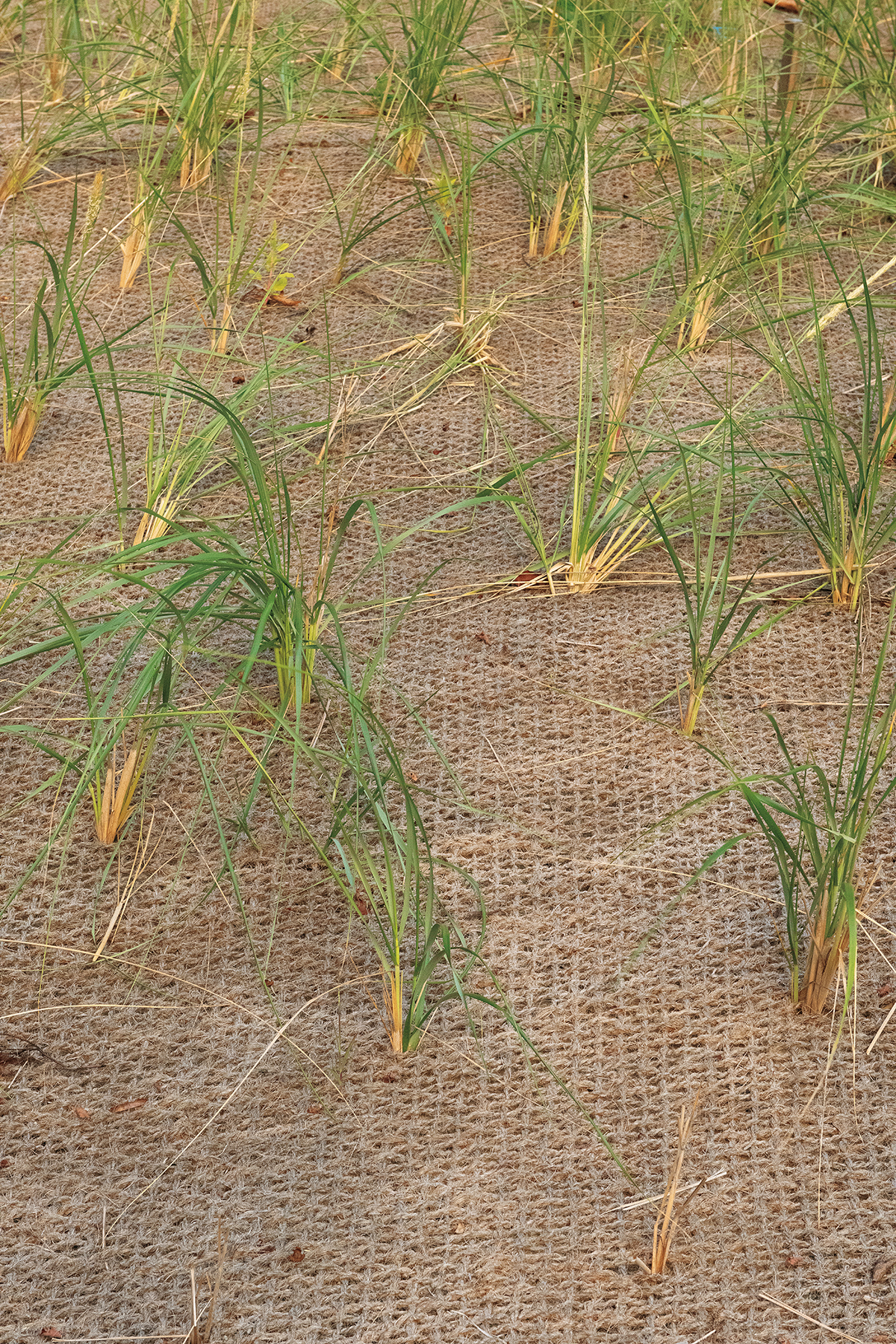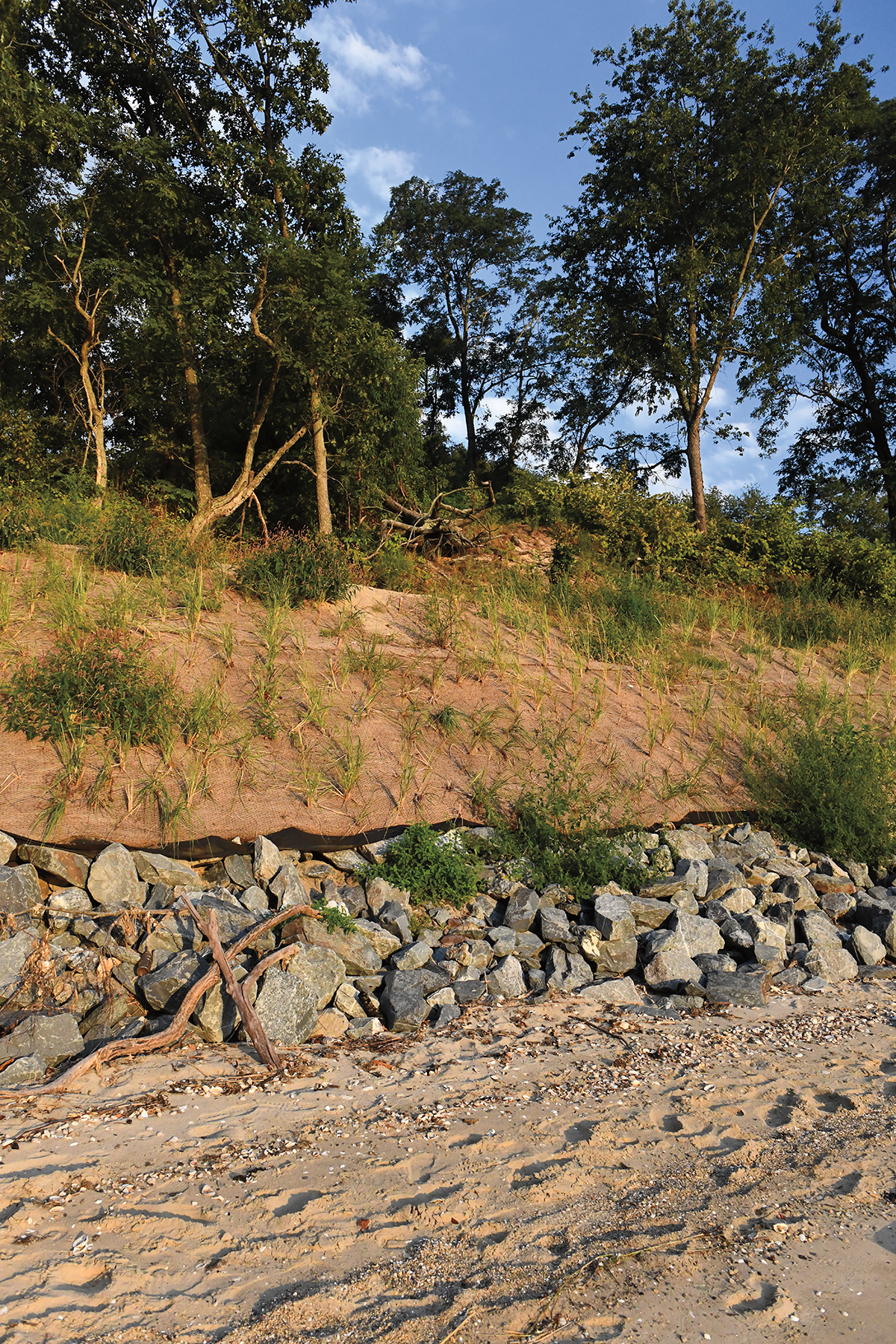The Experimental Coast
RHODE ISLAND'S LIVING SHORELINE PROJECT COULD REDUCE EROSION
By Annie Sherman | Photographs by Monica Allard CoxWALKING DOWN THE BEACH AT ROSA LARISA PARK in East Providence’s Riverside neighborhood, Janet Freedman points out the visible signs of erosion. Trees are sliding over the silty, 40-foot bluff as if chopped at their ankles, the concrete sea wall has crumbled in large chunks that lay abandoned along the narrow shore, and ruins of ferry dock pilings sprout from the surface as a reminder of the Crescent Beach amusement park and Shore Dinner Hall that was built in the 1860s.
Narragansett Bay’s increasing wave action and rising sea levels are the effects of global warming and have caused the beach and steep wall of sediment to erode, says Freedman, a coastal geologist at the Rhode Island Coastal Resources Management Council (CRMC). But a new nature-based experiment that she is co-piloting with The Nature Conservancy (TNC) might help restore the coastline, using plants and natural materials to help rebuild from the ground up.
“With sea level rise, you can only walk this beach at low tide. And the bluffs are eroding as waves undercut the base of the slope, then the trees and stone wall remnants are at the mercy of gravity, falling off the bluff and taking sediment with them. It’s a constant process,” Freedman says. “There have been so many different attempts to stop erosion here, and they work for a while, but they’re not permanent. We needed to come up with an alternative to putting in a seawall and taking away public access. We are going to lose more and more beach, so we asked ourselves, ‘Are there other things we can do that will protect this bluff and allow public access?’”
Instead of depleting the shoreline with another abiotic concrete wall, a nature-based approach featuring stone, natural plantings, and biodegradable materials is more environmentally compatible with the existing ecosystem, says John O’Brien, policy and partnership specialist at TNC. The strategy had worked elsewhere to restrict bluff erosion and create habitat, so TNC and CRMC collaborated with the city of East Providence to try it here.
Two installation sites on the beach cover 230 linear feet, including intertidal sills with beach grass plantings and coconut coir log revetments buried 30 feet up the slope that literally shore up the shore. Both sites feature layers of rock and fibers submerged in the ground to establish a strong foundation, topped by native Rhode Island plantings to secure everything in place.
The four rock sills set at mid-tide protect a garden of 2,000 Spartina and Distichlis salt grass plants growing through a layer of fabric made of biodegradable coconut fibers. High tide washes over the sills completely, so they are spaced 5 feet apart to allow drainage and escape for any sea creatures trapped behind them. The salt grass plants will grow to form a dense wetland that binds the soil in place. O’Brien says this new tidal marsh will stop waves before they reach the bluff.
“Rather than concrete or sheet piling, we added a series of rock sills in front to cut down on wave energy, as well as marsh grasses that are nature’s way of reducing incoming energy,” O’Brien explains. “This is just the beginning. The marsh will expand, so the bluff will be protected.”
About 100 yards along the beach toward Sabin Point, the second site offers a series of coconut coir logs interred deep in the slope beneath more coconut sheeting and salt grasses. Coupled with a rock toe at the base to disrupt the force of waves here, the bluff won’t ooze into the Providence River.
“Stone lasts longer than coconut coir fabric, but the test is to see if the bluff gets established with a blanket of living stem and root vegetation to stabilize it and make it resistant to the type of storm energy it sees,” O’Brien says. “There are other spots in Rhode Island where this could be beneficial.”
The sensitivity and potential for this coastal garden experiment means Freedman and O’Brien treat it as their pet project. Both tend the fencing around the marsh plants to keep hungry geese away and clear debris or seaweed that has washed in with the tide. They check the installations weekly, analyze progress, and take it personally when a plant doesn’t make it. The Distichlis, for example, wasn’t flourishing after six weeks, they say, but they’re hopeful it will develop in time.
Construction was completed in May, and Freedman and O’Brien will continue monitoring for three years through photographic and biological analysis. Wooden posts around the sites offer a stable and consistent camera mounting spot to take photos over time, where they can evaluate the effects across the whole installation to see where it’s working and ensure there aren’t unintended consequences.
“We want to see if it creates erosion elsewhere, or other impacts. It’s good to have controlled and uncontrolled sections of the shoreline so we can compare,” Freedman says. “We were not sure if the structures would cause erosion in adjacent areas, but it looks like [they’re] doing okay.”
Professor Stephen Licht from the University of Rhode Island is leading a team of engineering students taking aerial drone surveys, pre-and post-construction as well as after storms, to gauge sediment fluctuation and movement of the installations themselves. Creating 3D images and digital elevation models, called photo mosaics, using “structure from motion” technology, they collect topographical data that will complete a larger state database.
“It can be a great tool, but we need to know more about it,” O’Brien says. “We aspire to assemble a document about integrated coastal restoration and nature-based approaches versus alternate hard methods, to provide guidance for state agencies, engineers, and private homeowners to solve the eroding shoreline.”
Adjacent homeowners also have been making their own efforts to secure their properties for decades. Freedman says there were 47 recent applications to CRMC for new structures within a mile of this site.

They are already allowed to build shoreline structures because this is classified as a Type 2 low-intensity shoreline, so they don’t need a variance or special exception from CRMC. But she and O’Brien advise home-owners to consider methods other than retaining walls and hard structures as erosion protection. Mayor Bob DaSilva, who says he has fond memories of the area from childhood, when he enjoyed the amusement rides at Crescent Park, recognizes the need for a new approach to erosion control.
“Previous actions such as the replacement bulkheads, riprap, and seawalls failed,” he says. “I think this project is fantastic. There has been a well-thought-out approach among partners to restore the shoreline for generations to come to enjoy our beautiful coast.”

Plants emerge through the coconut-fiber fabric, as intended, as part of the bluff stabilization project at Rose Larisa Park.
City engineer Erik Skadberg echoes the concern for this site, witnessing its decline for 15 years. The city has largely left the site alone, so the beach has little buffer from increased wave action and rising seas, while a second graffitied retaining wall, built decades ago, no longer offers sufficient support for the bluff. Trees continue to fall and block the beach, which becomes an issue of public safety and city maintenance. So much of the sand has eroded that the city has had to keep adding bottom steps to the stairway leading down from the park to the beach.
“Some of those walls are close to 100 years old, and environmental conditions are worse now. That bank keeps sliding down towards the beach,” he says. “This has been on our radar, and it’s a local beach area so residents use it actively. I think this will do a good job with everyday wave action.”
In addition to providing construction materials, Skadberg and his team created a survey and existing conditions plan, which was included in the $142,000 grant application to National Oceanic and Atmospheric Administration. As part of a $1 million regional TNC program to support coastal restoration across New England, states share what they have learned with each other. Additional funds from 11th Hour Racing and CRMC’s Coastal and Estuarine Habitat Restoration Trust Fund completed the $232,000 price tag. Ocean-facing beaches shift constantly thanks to Mother Nature, but even in Narragansett Bay, shore-lines are vulnerable around the state.
Freedman, O’Brien, and others are cautiously optimistic that this experiment will work and can be applied to other shovel-ready projects.
“This is not designed for 100-year storms. The design life will be 20 years, and the coconut coir will break down in seven to 10 years, depending on the sunlight, then hopefully the plants take over. We can tell how it’s working if it survives a big storm, like a hurricane Irene or Sandy,” Freedman says.
“Nature has a great resilience,” O’Brien adds. “But we need to see a change in the approach to shoreline erosion, and certainly an increase in funding.”
Contact Us
Telephone: (401) 874-6805
Email: allard@uri.edu
Contributor Guidelines
Please review submission guidelines to be considered. d

